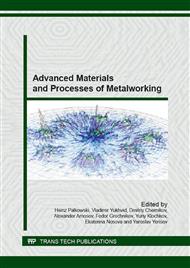[1]
T. Raslear Alerting Lights on Locomotives. Research Results RR07-17 (2007) 1-4.
Google Scholar
[2]
N.L. Kazanskiy, S.B. Popov, The distributed vision system of the registration of the railway train. Computer Optics, Vol. 36, № 3, (2012) 419-428.
Google Scholar
[3]
N.L. Kazanskiy, S.B. Popov, Integrated Design Technology for Computer Vision Systems in Railway Transportation . Pattern Recognition and Image Analysis, Vol. 25, No. 2, (2015) 215-219.
DOI: 10.1134/s1054661815020133
Google Scholar
[4]
V.A. Markov, V.I. Pusev, V.V. Selivanov, On issues of damping and shock-absorbing properties of materials and constructions. Science and Education (electronic edition), No. 6, (2012).
Google Scholar
[5]
M.A. Golub, N.L. Kazanskii, I.N. Sisakyan, V.A. Soifer Computational experiment with plane optical elements. Optoelectronics, Instrumentation and Data Processing, No. 1, (1988) 78-89.
Google Scholar
[6]
N.L. Kazanskiy, V.V. Kotlyar, V.A. Soifer, Computer-aided design of diffractive optical elements. Optical Engineering, Vol. 33, № 10, (1994) 3156-3166.
DOI: 10.1117/12.178898
Google Scholar
[7]
William Kay Bradley, U. S. Patent 20130051045. (2011).
Google Scholar
[8]
Jeffrey M. Singer, David Barnett, Scott R. Mangum, U. S. Patent 8403530. (2012).
Google Scholar
[9]
O. I. Lupanov. R.U. Patent 2529518. (2014).
Google Scholar
[10]
S.R. Abulhanov Vibration resistance of the head-lamp design with LED light sources for electric locomotives. Bulletin of the Volga Region Transport, No. 1 (43), (2014) 44-51.
Google Scholar
[11]
S.R. Abulkhanov Construction of authentic 3-D model of head-lamp of electric locomotive VL series. Herald of Samara State University of Communications, Vol. 3(17), (2012) 81-86.
Google Scholar
[12]
N. Kazanskiy, R. Skidanov. Binary beam splitter. Applied Optics, Vol. 51, No. 14, (2012) 2672-2677.
DOI: 10.1364/ao.51.002672
Google Scholar
[13]
E.R. Aslanov, L.L. Doskolovich, M.A. Moiseev, E.A. Bezus, N.L. Kazanskiy Design of an optical element forming an axial line segment for efficient LED lighting systems. Optics Express, Vol. 21, № 23, (2013) 28651-28656.
DOI: 10.1364/oe.21.028651
Google Scholar
[14]
S.V. Karpeev, V.S. Pavelyev, S.N. Khonina, N.L. Kazanskiy, A.V. Gavrilov, V.A. Eropolov, Fibre sensors based on transverse mode selection. Journal of Modern Optics, Vol. 54, № 6, (2007) 833-844.
DOI: 10.1080/09500340601066125
Google Scholar
[15]
N.L. Kazanskiy, S.B. Popov, Machine Vision System for Singularity Detection in Monitoring the Long Process. Optical Memory and Neural Networks (Information Optics), Vol. 19, No. 1, (2010) 23-30.
DOI: 10.3103/s1060992x10010042
Google Scholar
[16]
N.L. Kazanskiy, P.G. Serafimovich, S.N. Khonina Harnessing the Guided-Mode Resonance to Design Nanooptical Transmission Spectral Filters. Optical Memory and Neural Networks (Information Optics), Vol. 19, No. 4, (2010) 318-324.
DOI: 10.3103/s1060992x10040090
Google Scholar
[17]
N.L. Kazanskiy, P.G. Serafimovich, S.N. Khonina, Use of photonic crystal cavities for temporal differentiation of optical signals. Optics Letters, Vol. 38, No. 7, (2013) 1149-1151.
DOI: 10.1364/ol.38.001149
Google Scholar
[18]
E.A. Bezus, L.L. Doskolovich, N.L. Kazanskiy, Low-scattering surface plasmon refraction with isotropic materials. Optics Express, Vol. 22, № 11, (2014) 13547-13554.
DOI: 10.1364/oe.22.013547
Google Scholar
[19]
N.L. Kazanskiy, P.G. Serafimovich, Coupled-resonator optical wave-guides for temporal integration of optical signals. Optics Express, Vol. 22, No. 11, (2014) 14004-14013.
DOI: 10.1364/oe.22.014004
Google Scholar
[20]
A.V. Egorov, N.L. Kazanskiy, P.G. Serafimovich, Using coupled photonic crystal cavities for increasing of sensor sensitivity. Computer Optics, Vol. 39, No. 2, (2015) 158-162.
DOI: 10.18287/0134-2452-2015-39-2-158-162
Google Scholar
[21]
N.L. Kazanskiy, S.I. Kharitonov, S.N. Khonina, S.G. Volotovskiy, Yu.S. Strelkov, Simulation of hyperspectrometer on spectral linear variable filters. Computer Optics, Vol. 38, № 2, (2014) 256-270.
DOI: 10.18287/0134-2452-2014-38-2-256-270
Google Scholar
[22]
N.L. Kazanskiy, S.I. Kharitonov, L.L. Doskolovich, A.V. Pavelyev, Modeling the performance of a spaceborne hyperspectrometer based on the Offner scheme. Computer Optics, Vol. 39, № 1, (2015) 70-76.
DOI: 10.18287/0134-2452-2015-39-1-70-76
Google Scholar


